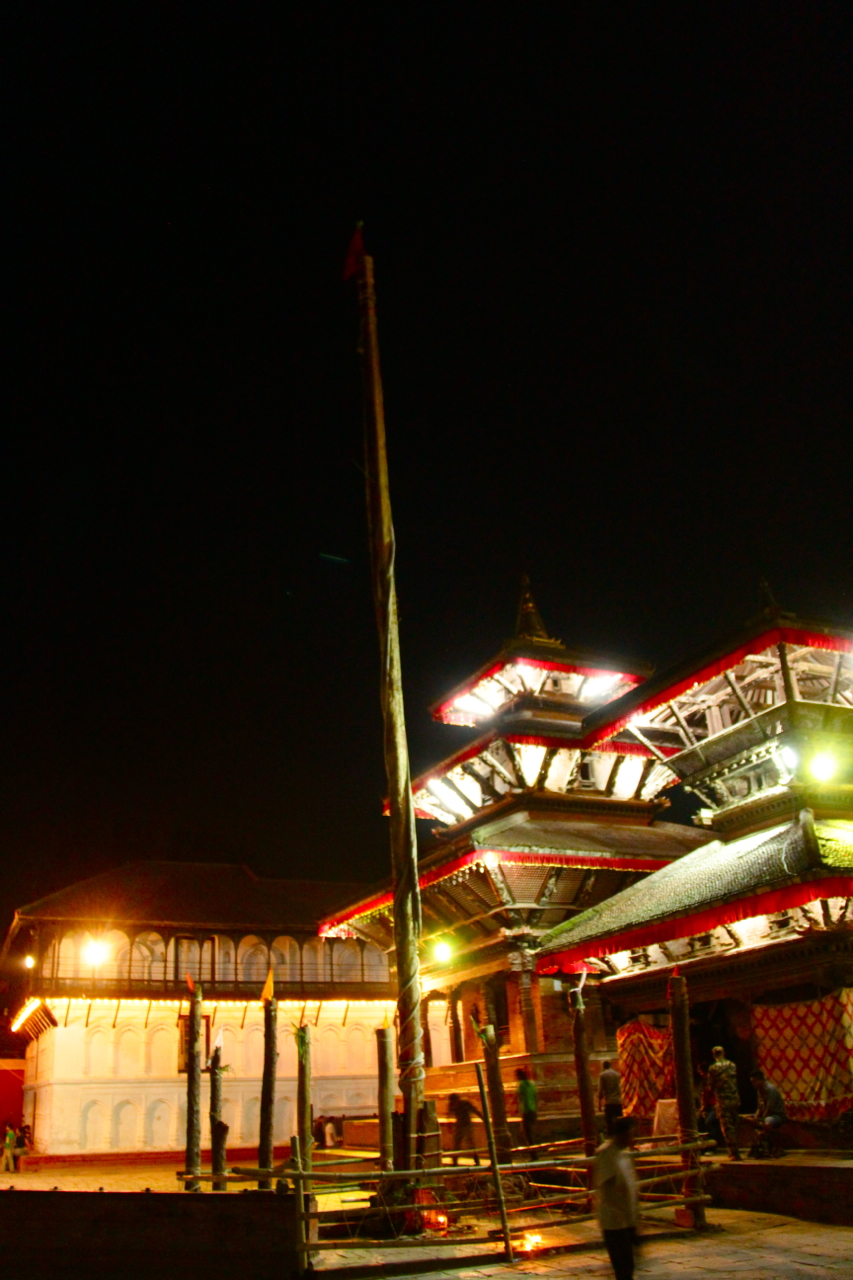
Welcome guest, you can login or create an account
Eight-day Festival Indra Jatra

Day 1
1. About a 35-feet long wooden pole called Indradhoj is errected at Layakuli (Drubar) Square.
2. A miniature golden idol of Indra riding on an elephant is set at the bottom of the pole following the religious ceremonies. A policeman guards it 24 hours a day for eight days.
3. An idol of Indra with his outstretched and tied hands is set on about 20-feet high wooden platform at Maru tole.
4. Huge mask of Akash Bhairava is opened to the public for making offerings at Layakuli on the first day and kept opened for eight days.
5. Swet Bhairava is displayed at Indrachok for the same purpose.
6. Lakhe, Pulu kishi, and Sawa-bhaku dancers start off their performances at Layakuli on the first days to register their attendance to Goddess Taleju, and continue their performances at other places for eight days.
7. Buddhists go making offerings of oil lamps to the deities in the names of their deceased loved ones in the areas of old Kathmandu in the evening. This is called ‘upaku onegu.’
8. About ten-feet high almost triangular-shape wooden stand with a number of slots for holding oil lamp are set at Maru tole. In the evening oil lamps are set in the slots for eight nights.
9. Pancha Buddha dance is performed at Layakuli, and other main squares.
10. Shadow images of ten incarnations of Lord Vishnu are shown at the temple of Lord Narayan at Maru tole every night during the Indra Jatra festival.
Ten incarnations of Lord Vishnu are 1) Matsya or fish 2) Kurma or tortoise, 3) Varaha or boar, 4) Nrishimha or man-lion, 5) Vamana or dwarf, 6) Parasuram, 7 Ram Chandra, 8) Krishna, 9) Buddha (Buddhists oppose it), and 10) Kalki Avatar
Day 2
1. Performances of dances of Lakhe, Pulu kishi, and Sawa-bhaku are continued starting in the afternoon, and ending in the night.
2. Devotees make offerings to Akash Bhairab at Layakuli, and Swet Bhairab, and Indra at Maru tole throughout the day.
Day 3
1. The first day of the festival of pulling of chariots of Living Goddess Kumari, Living God Ganesh, and Living God Batuka Bhairab. The chariot of Kumari is a three-storey high, built in the shape of a Sriyantra: the most auspicious symbol. The chariots of Ganesh and Batuk Bhairab are single storey high.
2. In the afternoon, all three living deities are placed on their respective chariot.
3. The head of state makes offering to the three deities before starting the festival of pulling the chariots.
5. Chariot of Ganesh leads the chariot of Batuk Bhairava, and then of the Kumari to the south-side of old Kathmandu, and then back to Layakuli.
6. Performers of Lakhe, Pulu kishi, and Sawa-bhaku dances go ahead of the chariots performing dances on the way.
7. In the night, Da-gi (Indra’s mother) goes around looking for her son Indra that had come to earth to pick a flower called ‘parijat’ for his mother da-gi. Sons and spouses of the deceased during the year follow Da-gi hoping to go to the heaven with Da-gi to meet their loved ones.
8. A series of oil lamps set on bamboos called ‘bau-mata’ is taken around the town following the route of da-gi apparently for giving the light to da-gi on her way.
Day 4
1. The three living deities on their respective chariot travel to the northern part of the old Kathmandu, and back to Layakuli in the evening. Performing Lakhe, Pulu kishi, and Sava-bhaku lead the way of the three chariots.
2. Making offerings to the deities on display continues.
3. People make offerings to Indra in an oil lamp called ‘dal-lu’ in the evening, and appreciate the god for making the rains given for rice plantation, and then ask the god to stop the rains as no more rains are required for the rice crops; after the worshipping, devotees feast on ‘samayabaji:’ the god-blessed food comprising flattened and puffed rice, grilled meat (chyoala), roasted black soybeans, and pieces of ginger, eggs and drink home-made rice beer called ‘thon’.
Day 5
1. Performances of Lakhe, and Pulu kishi dances continue in the night starting in the afternoon.
2. Deities on display at Layakuli, Indrachok, and Maru tole continue receiving offerings from the devotees throughout the day and late night.
Day 6
1. Lakhe and Pulu kishi dances continue.
2. Devotees visit the deities on display
Day 7
1. Lakhe and Pulu kishi dances continue.
2. Devotees visit the deities on display
Day 8
1. Chariots of Kumari, Ganesh and Batuk Bhairava are pulled to Kilagal, and then back to Layakuli.
2. Lakhe and Pulu kishi dancers perform ahead of the chariots.
3. The head of state receives ‘tika’ blessing from the Living Goddess Kumari at the Kumari House as a mandate to govern the State for a year.
4. All the deities on display go to their respective shrine.
5. The golden Indra set at the foot of the Indradhoj on the first day of the festival is taken for safekeeping.
6. The Indradhoj is pulled down and the pole is dragged to the bank of Vishnumati River, and burned it down there.
Thus, ends the eight-day Indra Jatra festival.


